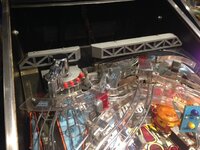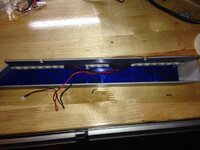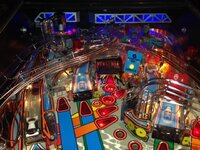There are two plastic girders that run along the top of the backboard of Demolition Man that sit dark 95% of the time despite having transparent blue plastic worked into their design. This is an area BEGGING to be lit up. There are three flashers back there...but their use is limited, leaving the plastics dark most of the time.
I've seen TNT Amusements drill out an extra four or five holes in the backboard and install sockets so that superbright LEDs can be placed in there. This option makes for a very centralized and distracting lighting effect. I picked up a few SMD light strips from Comet LED (a steal at $2.95USD per strip, available in both 3- and 7-SMD versions in a variety of colours: http://www.cometpinball.com/6-3-V-Plug-Play-Strips-Comet-Pinball-p/6.3vsmdstrips.htm). I hoped this would give the light more wash, rather than the centralized throw found in TNT's modification of the game.
As you can see from the image above, each SMD strip comes complete with three different female ends, depending on how you want to hook up the lights. This also makes for less of a destructive footprint when drilling out the backboard: you need only drill a hole large enough to feed the female lead of the wire through, rather than having to feed the entire socket through. I went with Comet's blue SMD strips...but I suppose white would have worked as well, as the transparent plastic already has a blue hue. I wired up the lights for each plastic girder to one common lead as seen in the photo below. The smaller left girder was lit using two 3-SMD strips, and the larger right one (pictured below) was lit using two 7-SMDs and one 3-SMD. No modification to the plastic pieces themselves needed to be done...the SMD stips come with adhesive backing. I attached them to the inside top of the plastic allowing the SMD glow to shine downward rather than directly at the player.
With a common lead for each, I needed only drill two holes in the backbox to feed the female lead through. Once fed through, I attached the male 47-bulb style end. To keep things tidy, I wired in two extra sockets off of the general illumination string that lights up the rear portion of the playfied (which are also mounted to the backside of the backboard). Leads plugged into the sockets and voila...a nice subtle blue glow to the upper rear of the playfield. Matches the overall "blue-ness" of the game, and makes for a great contrast against the red lights of the ACMAG and Cryo-Claw. Even with being constantly lit, the flashers still have a descernable effect when they are activated.
I've seen TNT Amusements drill out an extra four or five holes in the backboard and install sockets so that superbright LEDs can be placed in there. This option makes for a very centralized and distracting lighting effect. I picked up a few SMD light strips from Comet LED (a steal at $2.95USD per strip, available in both 3- and 7-SMD versions in a variety of colours: http://www.cometpinball.com/6-3-V-Plug-Play-Strips-Comet-Pinball-p/6.3vsmdstrips.htm). I hoped this would give the light more wash, rather than the centralized throw found in TNT's modification of the game.
As you can see from the image above, each SMD strip comes complete with three different female ends, depending on how you want to hook up the lights. This also makes for less of a destructive footprint when drilling out the backboard: you need only drill a hole large enough to feed the female lead of the wire through, rather than having to feed the entire socket through. I went with Comet's blue SMD strips...but I suppose white would have worked as well, as the transparent plastic already has a blue hue. I wired up the lights for each plastic girder to one common lead as seen in the photo below. The smaller left girder was lit using two 3-SMD strips, and the larger right one (pictured below) was lit using two 7-SMDs and one 3-SMD. No modification to the plastic pieces themselves needed to be done...the SMD stips come with adhesive backing. I attached them to the inside top of the plastic allowing the SMD glow to shine downward rather than directly at the player.
With a common lead for each, I needed only drill two holes in the backbox to feed the female lead through. Once fed through, I attached the male 47-bulb style end. To keep things tidy, I wired in two extra sockets off of the general illumination string that lights up the rear portion of the playfied (which are also mounted to the backside of the backboard). Leads plugged into the sockets and voila...a nice subtle blue glow to the upper rear of the playfield. Matches the overall "blue-ness" of the game, and makes for a great contrast against the red lights of the ACMAG and Cryo-Claw. Even with being constantly lit, the flashers still have a descernable effect when they are activated.




